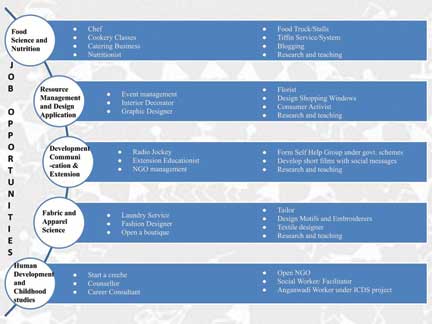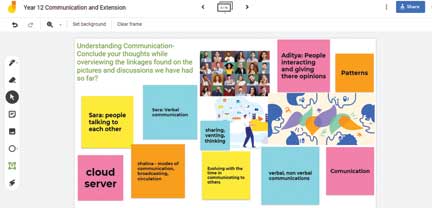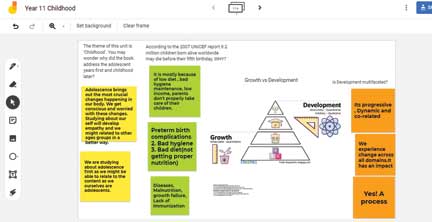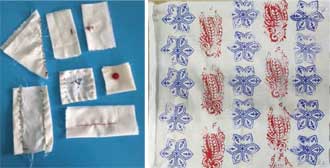Varuna Nagpal
I was born and brought up in Meerut, Uttar Pradesh where I also did my schooling. At that time, home science was extremely popular and my family was keen that I take up this skill based professional course. The holistic nature and seamless application of concepts in day to day life made me feel inclined and connected to the subject. After I completed my PhD, I had the option to choose from various opportunities. However working with children was my first choice and the school space was the most fertile ground to learn, to unlearn and explore one’s thoughts with young, creative, and curious minds.

Exploring home science
Current scenario at school: Our two batches of students have passed out; the current batch is appearing for the Board practical examination. We always had a mixed group of boys and girls and in the present batch we have more boys than girls. The reason for boys or girls to take the subject depends on the career choice they wish to make in future. I always suggest to my students to pick up subjects carefully and make the most of the concepts and knowledge they gain along the way. While choosing a career, there are students who are extremely good in sports and they want to take up sports nutrition so my suggestion to them was to choose physical education, biology, psychology, and home science as these subjects can make the conceptual understanding easier. Similarly for students who wish to take up culinary arts, food technology, fashion merchandising, fashion blogging, interior design or work in the hospitality industry, home science is the ideal choice.
We are a new school and I have seen a rise in the number of students opting for home science. I have friends and colleagues who are home science educators, and they have shared that the numbers are increasing every year. They teach 75-100 students in every batch.

Curriculum
Home science is a subject that is holistic in nature. The new syllabus is aligned with the needs and demands of the present and students have appreciated and enjoyed the theory and practical work so far. The subject gives them life skills which helps them build a happy and secure future. Every student benefits from every branch of home science and gets a deeper insight into the choice of career he/she wishes to take up. For example, during the initial days of lockdown when we focussed on the pandemic, students were able to review and relate to the demands of public health and read about the various nutritional programs for the overall well-being of the citizens. The field of human development and childhood studies gave an opportunity to step inside the pre-school space and learn from ecology.
Teaching and learning
During the pre-covid times, we took our students to the pre-primary and primary department in our school to observe, review and understand the fantastic job teachers were doing for the overall development of little children. Students were interested and intrigued about this field. Every element of the students’ classroom – the seating plan, colors on the wall, the choice of furniture, the displays, etc.., made them reflect on the theoretical knowledge they gained in the classroom.
The new syllabus gives us an option to conduct the practicals in the laboratory, online or in the classroom. We had completed most of the practicals online during class time and as the school reopened we successfully conducted experiments using applied textile design techniques – tie and dye and block printing, stain removal and qualitative test for food adulteration. The tie and dye practical was a major hit amongst the students and even the students who visited our lab to see what we were doing were keen to understand the process.

Home science gives us teacher sample opportunities to collaborate and create space for merging many disciplines. For the academic year (2018-19), I collaborated with other departments to help my students understand the multidisciplinary nature of the subject. We have subject experts in one area or the other and collaboration helps in sharing the best and core component of the topic to be taught. It gives an opportunity to learn from a fellow colleague and create a healthy and positive environment. For example, the chemistry department helped in carrying out the theory and practicals of stain removers, adulteration, and water purification system (old syllabus). Live demonstration of stain removal and hands-on practice of the same was carried out for the students. Students actively participated in checking the adulterants in the food items which they had brought from home. Safety precautions and application of these chemicals were explained in detail and students individually performed each sample test by themselves. As part of a water testing survey, students tested school water for its purity in the chemistry laboratory too. The concept of RO was demonstrated and explained using videos and articles.

Fine Arts
Design, colors, textures, shapes, etc.., are the dominant characteristics in fine arts. The fine strokes, colour combinations, textures and flow of designs helped in designing mood boards, costumes for individuals with different body type, silhouettes, embroideries and weaves. First-hand experience was given to students in developing paper sample of designs to put theory in practice.
Technology also finds its place in our teaching practices. This year during the online classes, we used tools like Padlet, Jamboard, SWAY and Nearpod to make teaching and learning collaborative and interesting. Discussions with experts help us in building a community of learners and keeping us up-to-date with new research and essential information.
Perception about home science
We conduct a common seminar for students and parents in collaboration with the career guidance cell in our school. These sessions are led by teachers, students and alumni. These sessions help clear the myths about the subject and explain its holistic nature.
The author holds a Doctorate in Human Development and Childhood studies from the University of Delhi. She is an educator, researcher and aims to design culturally appropriate and sustainable learning aids for children. She can be reached at varunanagpal@gmail.com.
